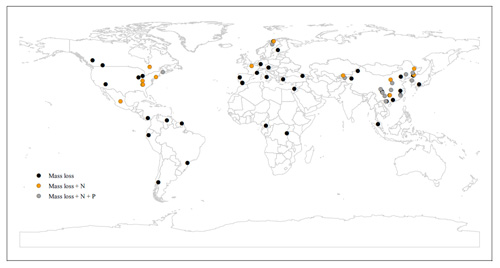| Location: Home>News>Research news |
| Study Reveals Diversity-decomposition Relationships across the Earth’s Major Forests |
|
|
Forests harbor the largest biodiversity among terrestrial ecosystems and mediate biosphere-atmosphere carbon (C) dynamics via primary productivity and decomposition. The biodiversity of organisms involved in C and nutrient cycling can modify these ecosystem processes, for example, during the decomposition of plant litter that typically occurs in mixtures. Litter mixtures can decompose at different rates than would be predicted from the rates of the individual component species, resulting in non-additive effects with either faster or slower decomposition. Although plant species diversity can affect C and nutrient cycling during litter decomposition, the generality of the direction of this effect and its magnitude remains uncertain. Associate Professor, KOU Liang at the Institute of Geographic Sciences and Natural Resources Research (IGSNRR), Chinese Academy of Sciences (CAS) and his colleagues evaluated how changing plant diversity affects C, nitrogen (N), and (P) dynamics during decomposition via distinctively diverse litter mixtures in the major forest biomes across the globe. This work was published in eLife on August 4, 2020. The global meta-analysis indicated that decomposition was faster when litter was composed of more than one species, and the synergistic effects were mostly driven by temperate forests but were more variable in other forests. The mixing effects varied depending on decomposition stages, with additive effect in the initial leaching stage (<10% mass loss), strongly synergistic effect in the early stage (10–40% mass loss), and weakly synergistic (40–60% mass loss) or additive (>60% mass loss) effect in the later stage. Synergistic interactions emerged in both planted and natural forests. In planted forests, understory plants were an important driver of synergistic effects while in natural forests the composition of overstory trees had a predominant control over the mixture effects. The presence of deciduous species in a leaf mixture facilitated the synergistic effects which can be well predicted by the initial chemical trait divergence among component litter species in mixtures, such as potassium, calcium and magnesium concentrations, and N:P ratio. Furthermore, litter diversity accelerated N, but not P release, potentially indicating a decoupling of N and P cycling and perhaps a shift in ecosystem nutrient limitation with changing biodiversity. “These findings demonstrate the importance of litter diversity effects for C and nutrient dynamics during decomposition, and show how these effects vary with litter traits, decomposer complexity and forest characteristics,” the joint first author KOU Liang said. “For forest management these findings shed new light on the important role of the understory vegetation for biogeochemical cycling when forests are managed as plantations,” Prof. WANG Huimin from IGSNRR added. This study was done in collaboration with University of Montpellier and Chinese Academy of Forestry. This work was supported by the National Natural Science Foundation of China and National Key Research and Development Plan.
Reference: Kou L#*, Jiang L#, Hattenschwiler S, Zhang MM, Niu SL, Fu XL, Dai XQ, Yan H, Li SG*, Wang HM*. Diversity-decomposition relationships in forests worldwide. eLife, 2020, 9: e55813. DOI: 10.7554/eLife.55813. |
